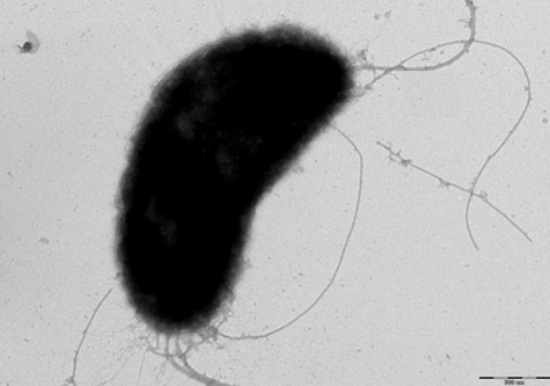Classification of Vibrio salmonicida
Domain: Bacteria
Phylum: Proteobacteria
Class: Gamma Proteobacteria
Order: Vibrionales
Family: Vibrionaceae
Genus: Aliivibrio
Species: Vibrio salmonicida
Domain: Bacteria
Vibrio
salmonicida is classified in this domain because it is a
bacteria. This means that it is prokaryotic, lacks organelles, does not have a
defined nucleus, and contains peptidoglycan in its cell wall.
Another organism in the domain bacteria is
Deinococcus radiodurans.

Phylum: Proteobacteria
These are Gram-negative bacteria, which all have a spherical or
spiral shape. They are aerobic heterotrophs with respiratory
metabolism. They contain polar flagella which gives them motility
and a rigid cell wall. This phylum is usually aquatic (Todar
2009).
Class: Gamma Proteobacteria
At the next level of classification, proteobacteria are divided into
six divisions or classes. These classes are determined by the rRNA
sequences (Encyclopedia of Life). Another interesting bacteria
within this class is
Xanthomonas campestris.
Order: Vibrionales
Because vibrionaceae is the only family found within the vibrionales
order (Encyclopedia of Life), there is very little information
distinctive to this order. As with the family, this order contains
many of the marine, and sometimes pathogenic, bacterium.
Family: Vibrionaceae
This family of bacteria is extremely diverse. They can be found in a
very wide array of habitats. One of the most common is a marine
environment. Bacteria found here are characteristically
bioluminescent. Also they often have mutualistic or pathogenic symbiotic relationships with
organisms in their marine environment (Nischiguchi, M.K. and V.S. Nair, 2003).
Figure 2. This phylogenetic tree shows the five classes of Proteobacteria, along with several lower classifications as well. Vibrio salmonicida is a Gamma proteobacteria (found on the left) and within the genus of Vibrio. This tree is based on genomic data.
Genus: Vibrio (Aliivibrio)
The most distinguishing feature putting Vibrio salmonicida
in this genus is the fact that it is oxidase-positive. Motility is from a
polar flagella and it can carry out both fermentation and oxidative
metabolism. As said before these bacteria are all Gram-negative and
rod-shaped. Many of them are also bioluminescent (Todar 2009).
Figure 2 highlights the relationship that Vibrio salmonicida
has with several other genera. One such is Salmonella,
another Gamma proteobacteria. Salmonella is commonly
recognized because of its reputation for infecting humans and
causing sickness. Like Vibrio it is pathogenic, but more
commonly to humans than fish.
Species: Vibrio salmonicida
This specific species of Vibrio is not bioluminescent, but
does carry the properties necessary to be so. It is rod-shaped, motile, and
acts as a pathogen to several fish species. It lives in cool
marine environments with a high salt content (Bjelland et al. 2012 a).
The word Vibrio is latin for the phrase 'to wave' (Vibrio).
This could be referring to the fact that this bacteria can carry up
to nine flagella (Bjelland et al. 2012 b), causing it to 'wave' as it moves. Salmonicida
relates to the fish, salmon. This is the fish most commonly infected
by Vibrio salmonicida and as a result has become part of
this bacteria's name.
Learn more about Vibrio salmonicida's Habitat or venture back to the Home Page.

